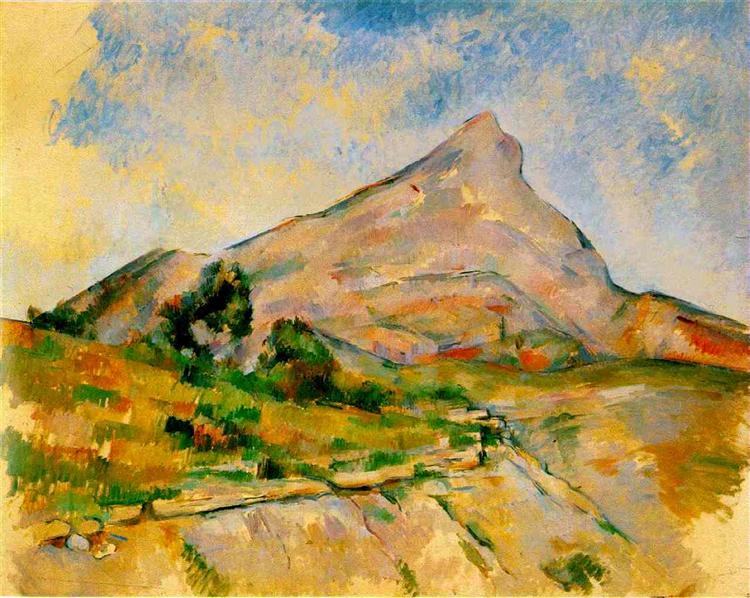Description
Paul Cézanne's painting "Monte Sainte-Victoire" (1898) is a monumental work that encapsulates the author's quest to translate the perception of the landscape through a distinctive vision of painting. In this work, Cézanne portrays the emblematic Mont Sainte-Victoire, one of his favorite themes, which became a symbol of the bridge between Impressionism and Cubism, as well as a reflection of his belonging to the Provençal region of France.
The work is characterised by its structured composition, in which Cézanne employs a meticulous arrangement of shapes and planes. The mountain rises in the background, formed by a series of triangles and gentle slopes that give a sense of grandeur and solidity. This almost architectural approach highlights the artist's fascination with form and structure, marking a clear departure from the more ephemeral and atmospheric treatment of landscape typical of Impressionism.
Cézanne uses a rich and varied palette, with blue and green hues predominating, giving life to the vegetation in the foreground, contrasting with the earthier and greyer tones of the background where the mountain is located. The brushstrokes, firm and decisive, unfold in multiple directions, suggesting both the texture of the landscape and the immediacy of the moment. This is a characteristic that can be observed in many of his works, where the surface of the painting becomes a focus of attention, almost like a living space in itself.
The way in which Cézanne captures light is also impressive. The sun's radiation bathing the landscape is manifested in the use of warm colours in certain parts, while the shadows, made with darker and colder tones, give dynamism to the surroundings. Thus, the light seems to interact with the shapes, highlighting their volumetry but at the same time insinuating an emotional depth that goes beyond the mere representational.
The absence of human figures or narrative elements in the composition is notable, which can be interpreted as a deliberate act by the artist to focus attention on the relationship between the landscape and the viewer. In this way, Cézanne succeeds in emphasizing the deep connection between humans and nature, producing a visual experience that invites contemplation and introspection.
Mont Sainte-Victoire is a recurring motif in Cézanne's work, used in various versions throughout his career. However, each interpretation reflects a conceptual and technical evolution that gives each one a uniqueness. In this sense, "Monte Sainte-Victoire" (1898) stands out for the clarity with which it expresses his interest in breaking down reality into its basic elements, anticipating later movements such as Cubism, which he himself would influence.
In the context of art history, this work by Cézanne is a manifestation of the paradigm shift that occurred at the transition from the 19th to the 20th century. It represents not only his technical mastery, but also his ability to transform the perception of the landscape, turning it into an almost philosophical experience. When looking at "Monte Sainte-Victoria", one perceives an invitation to reflect on our relationship with the natural environment, while celebrating the beauty of painting itself as a means of artistic expression. This work is a testament to the crucial role that Cézanne played in the evolution of modern art, establishing himself as a pioneer not only in his personal style, but in his lasting influence on later generations of artists.
KUADROS ©, a famous painting on your wall.
Hand-made oil painting reproductions, with the quality of professional artists and the distinctive seal of KUADROS ©.
Painting reproduction service with satisfaction guarantee. If you are not completely satisfied with the replica of your painting, we will refund 100% of your money.

